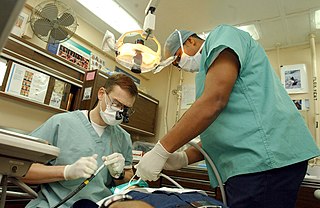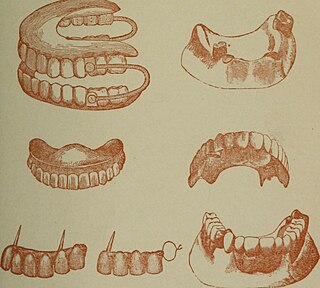
Dentistry, also known as dental medicine and oral medicine, is the branch of medicine focused on the teeth, gums, and mouth. It consists of the study, diagnosis, prevention, management, and treatment of diseases, disorders, and conditions of the mouth, most commonly focused on dentition as well as the oral mucosa. Dentistry may also encompass other aspects of the craniofacial complex including the temporomandibular joint. The practitioner is called a dentist.

In the United States, Medicaid is a government program that provides health insurance for adults and children with limited income and resources. The program is partially funded and primarily managed by state governments, which also have wide latitude in determining eligibility and benefits, but the federal government sets baseline standards for state Medicaid programs and provides a significant portion of their funding.

A dentist, also known as a dental surgeon, is a health care professional who specializes in dentistry, the branch of medicine focused on the teeth, gums, and mouth. The dentist's supporting team aids in providing oral health services. The dental team includes dental assistants, dental hygienists, dental technicians, and sometimes dental therapists.
The American Dental Association (ADA) is an American professional association established in 1859 which has more than 161,000 members. Based in the American Dental Association Building in the Near North Side of Chicago, the ADA is the world's largest and oldest national dental association. The organization lobbies on behalf of the American dental profession and provides dental accredation.
A Federally Qualified Health Center (FQHC) is a reimbursement designation from the Bureau of Primary Health Care and the Centers for Medicare and Medicaid Services of the United States Department of Health and Human Services. This designation is significant for several health programs funded under the Health Center Consolidation Act.
Teledentistry is the use of information technology and telecommunications for dental care, consultation, education, and public awareness.

The UCLA School of Dentistry is the dental school of the University of California, Los Angeles (UCLA) located in the Center for Health Sciences building in the Westwood neighborhood of Los Angeles, California, United States. The school has several educational and training programs, conducts oral and dental health research, and offers affordable dental care at three locations: Westwood, Venice, and Inglewood. The school also participates in several outreach endeavors, including numerous health fairs during the year, STEM pipeline programs and provides dental care for underserved populations in the region. The School of Dentistry is considered among the nation's best research-intensive dental schools.
The California Medical Assistance Program is the California implementation of the federal Medicaid program serving low-income individuals, including families, seniors, persons with disabilities, children in foster care, pregnant women, and childless adults with incomes below 138% of federal poverty level. Benefits include ambulatory patient services, emergency services, hospitalization, maternity and newborn care, mental health and substance use disorder treatment, dental (Denti-Cal), vision, and long-term care and support. Medi-Cal was created in 1965 by the California Medical Assistance Program a few months after the national legislation was passed. Approximately 15.28 million people were enrolled in Medi-Cal as of September 2022, or about 40% of California's population; in most counties, more than half of eligible residents were enrolled as of 2020.
Dental insurance is a form of health insurance designed to pay a portion of the costs associated with dental care.

A denturist in the United States and Canada, clinical dental technologist in the United Kingdom and Ireland, dental prosthetist in Australia, or a clinical dental technician in New Zealand is a member of the oral health care team and role as primary oral health care provider who provides an oral health examination, planning treatment, takes impressions of the surrounding oral tissues, constructs and delivers removable oral prosthesis treatment directly to the patient.

Dentistry throughout the world is practiced differently, and training in dentistry varies as well.
Special needs dentistry, also known as special care dentistry, is a dental specialty that deals with the oral health problems of geriatric patients, patients with intellectual disabilities, and patients with other medical, physical, or psychiatric issues.
The practice of dentistry in the United States is overseen by several agencies, including the American Dental Association, the Commission on Dental Accreditation, and the regional boards. Ultimate licensure is the responsibility of individual states. There are roughly 190,000 practicing dentists in the United States.
Aspen Dental Management, Inc. (ADMI) is an American dental service chain with nearly 350 offices in 22 states. Its headquarters is in Chicago, Illinois.

Small Smiles Dental Centers was a privately-owned US chain of dental clinics focused on serving children from low-income families. The parent company, Church Street Health Management (CSHM), has its headquarters in Suite 520 of the Castner-Knott Building in Nashville, Tennessee. As of 2010, Church Street was the largest dental management company in the United States, and for a period it was the largest dental chain for children in the United States. As of March 2014, Small Smiles had 53 offices, and it stated that it served hundreds of thousands of children annually. As of September 2021, Small Smiles appeared to have one location in Reno, Nevada.
The Area Health Education Centers (AHEC) Program is a federally funded program established in the United States in 1972 "to improve the supply, distribution, retention and quality of primary care and other health practitioners in medically underserved areas." The program is "part of a national effort to improve access to health services through changes in the education and training of health professionals." The program particularly focuses on primary care.
An accountable care organization (ACO) is a healthcare organization that ties provider reimbursements to quality metrics and reductions in the cost of care. ACOs in the United States are formed from a group of coordinated health-care practitioners. They use alternative payment models, normally, capitation. The organization is accountable to patients and third-party payers for the quality, appropriateness and efficiency of the health care provided. According to the Centers for Medicare and Medicaid Services, an ACO is "an organization of health care practitioners that agrees to be accountable for the quality, cost, and overall care of Medicare beneficiaries who are enrolled in the traditional fee-for-service program who are assigned to it".
The practice of dental care in rural Alaska is overseen by the American Dental Association and other organizations under the jurisdiction of dentistry in the United States, with major differences from dentistry in the contiguous states. The oral health situation among the Alaskan Native population is among the most severe globally, with notably high rates of oral disease. Children in this population aged 2 to 5 years have almost five times the amount of tooth decay as children of the same age elsewhere in the United States, and adults have 2.5 times the amount of tooth decay as adults elsewhere. Other factors impacting the population's dental health include the difficulty of obtaining fresh food in remote locations, lack of fluoridated running water, and reduced access to education on the importance of dental health.

Kool Smiles is a dental services provider, based in the United States. Its headquarters are in the Kool Smiles Patient Support Center in Marietta, Georgia, U.S., in Greater Atlanta and has over 100 offices located across sixteen states.
ReachOut Healthcare America (RHA) is a dental management services company with its headquarters in Farmington Hills, Michigan. It is a part of the private equity portfolio of Morgan Stanley. The company operates in 22 U.S. states. In 2011 the company coordinated dental care at 8,700 schools and coordinated the processing of 488,000 children in those schools. As of May 2012 the company has coordinated the processing of 1.5 million patients. ReachOut seeks to coordinate treatment for underserved children on Medicaid.







